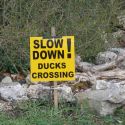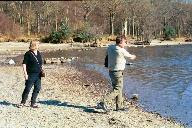Alarms set for 6 AM and, as usual, wake before them. Pretty silent walk down to the old town. Streetlights still on and little sign of human activity. Only a quarter to seven when we reach the end of the road where the taxis and buses gather. Just before seven, as the streetlights are going out a bus pulls In labelled Lisboa. But turns out to be the regular public Albufeira to Lisbon express. Then ours, a small Mercedes bus holding about 24 people, and just about full. But we’re lucky, because the tour guide removes her things from the front seat behind the driver. A huge advantage for us, really, because we have a good view through the windscreen, whereas the side windows are pretty well obscured with condensation.
An hour’s ride and then we stop at a roadside service station for coffee. Good coffee, cups individually made for a euro each, so now we’re awake. Landscape changes from hills to plains. Lots of olive trees, sometimes with sheep grazing under them. Sheep, of course, can survive on the most meagre pretence of vegetation, though environmentalist George Monbiot claims, probably accurately, that their grazing on hillsides causes erosion out of all proportion to any advantage to raising them.
First stop, for an hour, is on the outskirts of Lisbon, at Jerónimos Monastery, late Gothic, burial place of Vasco da Gama, now a museum. And, incidentally, the place where the EU’s Lisbon Treaty was signed in 2007. Across the road and accessible by tunnel is the Monument to Discoveries, celebrating the golden age of exploration. Statues face the “prow” of the monument, heading toward the sea, and include Vasco da Gama and Magellan.
Lisbon is an old city, but the massive earthquake that struck Portugal in 1755 destroyed most buildings, so with some happy exceptions the “old” structures are 18th century. Not too unusual for Canadian tourists. Our coach winds through streets and past squares which at first we think we’ll remember and in the end we know we won’t. Had downloaded a map of the city centre last night and am now met with a mildly interesting but mostly annoying technical explanation of what I should have done differently had I wished to use it offline. But fortunately the guide gives us tourist maps with a rather better than screen size insert for the city centre.
We have three hours on our own, and my hope is to go to the Alfama district, the old quarter that escaped destruction when the earthquake hit. Not far, or complicated according to our map. But the map is not of course topographical and I have an unfortunate tendency to feel (not think, I do know better) that locations nearer the bottom of the map must somehow be downhill. A sense that is exaggerated in this case by the fact that we actually are north of the harbour, and in strange cities built on the ocean heading downhill is usually a reliable way to find the waterfront. Well, we head south, but with Portuguese perversity there is a great deal of uphill involved. And as we enter the Alfama district the route abandons steep hills entirely and gives way to much steeper flights of stairs. Castelo de São Jorge (built by the Visigoths in the 5th century and enlarged by the Moors in the 9th century) is ahead of us, we’re repeatedly reassured by signs, although signs that cunningly omit any actual distances, as well, of course, as any gradient symbols. Unusually, J is the first to say that he isn’t going any farther - it’s just endless more flights of stairs. As does seem to be the case, and though it would be interesting to see the castle, we’re not actually all that desperate.
So back to where the stairs began, and a road that is happily much less touristy and commercial than where the coach dropped us off. Four tiny tables outside a little café maybe fifteen feet by twenty. Yes, you could eat inside, but barely. They do sandwiches or salads, both at pretty good prices. Or €1.60 for coffee and a pastry, about half what it would be in Albufeira old town, so we’re out of the tourist centre. Some discussion about the coffee. We want it preto - black. Espresso? No, just black, preto. Despite the presence of both tiny and larger cups, the man indicates that he can only do espresso. All right then. But the younger man asks the difference. Black coffee is bigger, but not so strong. So we could put the espresso in a larger cup and add water? Yes, says J. Americano. (Though we do point out that we ourselves are not Americano). Smiles all round, and a good cup of coffee with our custard tarts. Which are themselves streets better than the ones at Lidl, and we go back for seconds.
Back past the trams. Sit for a bit in a park with perfectly level paving giving a powerful optical illusion of a gently rolling surface. In the back streets find very attractive little cafés for full meals. But it’s too late.
Lisbon is situated where the River Tagus enters the sea and we head out of the city over the longest bridge in Europe, which does indeed seem endless. it’s 12.3 km, just under the length of the PEI Confederation Bridge, though without ice to contend with. Rainbow in the sky (it has showered off and on, but almost entirely when we were on the bus) gradually replaced by full moon to our left, accompanying us through the darkness on our way back. We’re in luck again when we reach the city, as the first drop off is about three blocks from home, so we get out and save ourselves the uphill trek through the old town.







